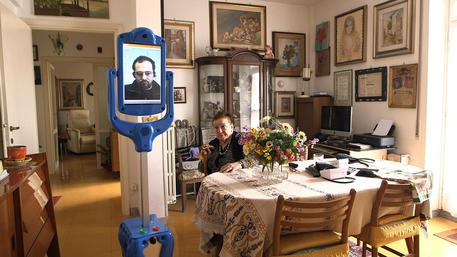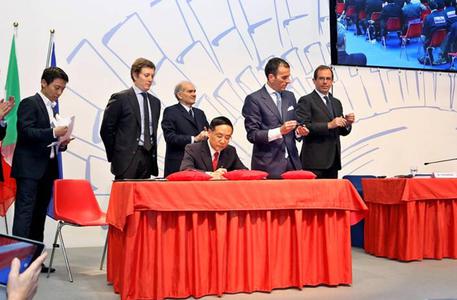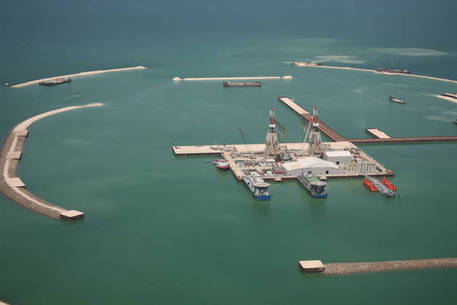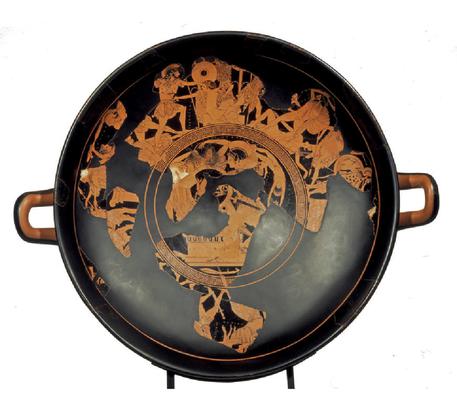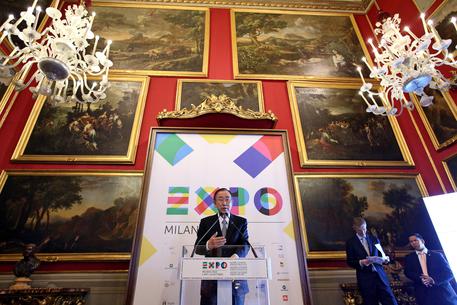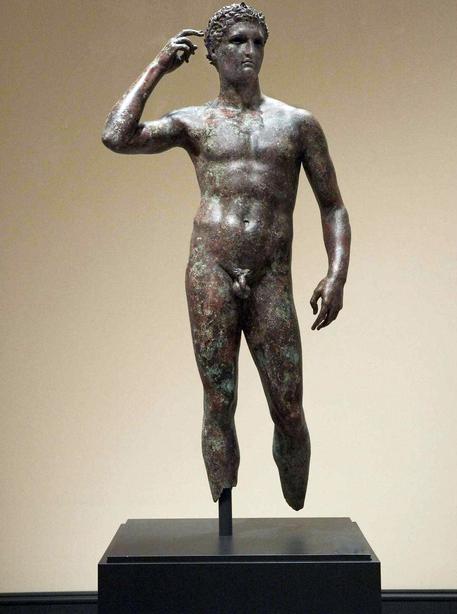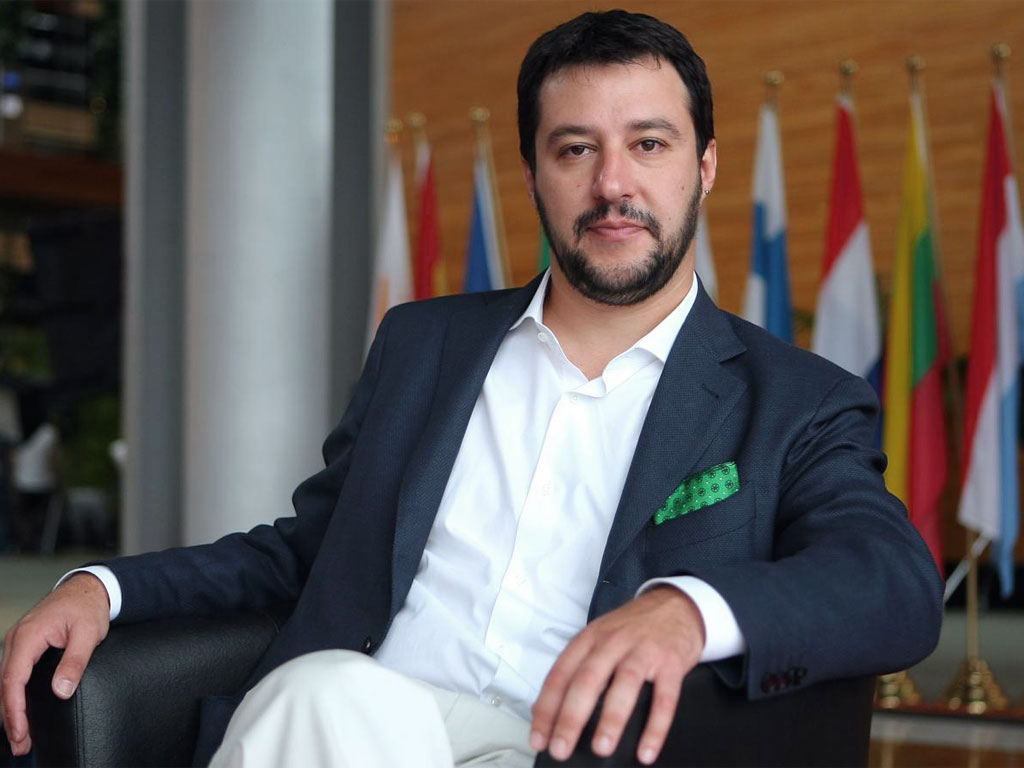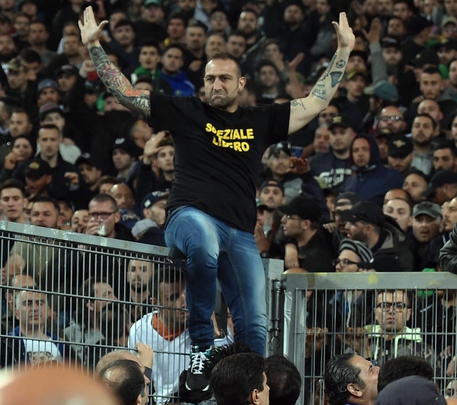Translate
venerdì 9 maggio 2014
94-yr-old in Rome lives w/robot care
EC programme tests new solution for independent living
(ANSA)
- Rome, May 9 - A 94-year-old grandmother in Rome is one of six
elderly people living with a robotic 'caretaker' as part of an
European Commission (EC) project, the EC said Monday in a statement.
The three million euro EC-financed project, called GiraffPlus, is
part of an effort to test how robots and other devices could help
older people live safer, more independent lives. "The EU is
investing in new technology that can support the silver generation -
adding not just years to our life, but also life to our years,"
said Neelie Kroes, vice-president of the European Commission and head
of the Digital Agenda. The system includes sensors and a robot, which
94-year-old Lea Mina Ralli calls 'Mister Robin'.
The sensors are designed to detect activities like cooking, sleeping or watching television, as well as to allow the person's caretakers to check remotely on well-being and for falls. The robot monitors such health indicators as blood pressure or sugar levels, and allows video calls to relatives, friends and doctors.
Ralli, aka 'Nonna Lea' (Grandma Lea), is a technology buff and has even dedicated a poem to the robot on a blog she keeps. "With this valuable assistant that I call 'Mr Robin', I'm more relaxed about the years ahead, and so are my children and grandchildren," explained Ralli. GiraffPlus is expected to be in 14 European homes by the end of 2014, put into commercial production next year. Costs will be based on an upfront fee and monthly subscriptions to make it competitive with full-time care.
German investment in Italy on the rise
Trade relations 'excellent and stable' between nations
(ANSA)
- Rome, May 8 - German investment in Italy rose by almost 11%, from
30.2 billion euros in 2009 to 33.1 billion euros in 2012, the Italian
chamber of commerce for Germany said Thursday. The number of Italian
companies with German stakeholders grew by almost 100 to reach 1,345
over the same period, which coincided with the economic crisis in
Italy. "Trade relations between the two countries are excellent
and stable," president of the Italian chamber of commerce for
Germany, Emanuele Gatti, told ANSA. "Trade activities currently
amount to over 100 billion euros with further predicted growth,"
Gatti said.
Italian goods worth 43.7 billion euros were exported to Germany from January to November last year. The chemical and metallurgy sectors each accounted for 13% of exports, followed by transport at 11%, food and agriculture at 7%, and textiles at 5%.
'Gaping hole' opens up in 'Italian Versailles' roof
'Maintenance problem' says superintendent
Caserta
- A hole has opened up in the roof of Italy's Versailles, the
18th-century UNESCO-listed Bourbon Palace of Caserta near Naples
whose rundown state has grabbed headlines over the last few years.
"At first we just saw light peeping through and then the hole
became gaping," said the head of the Reggia di Caserta special
superintendency, Flavia Belardelli. She said the damage was caused to
a part of the sprawling building occupied by the Italian air force,
who heritage bodies have vainly been trying to dislodge for years.
"It looks like a maintenance problem," Belardelli said.
The palace that once hosted the kings of Naples and Sicily, one of the lesser-known splendours of southern Italy, has been dogged with upkeep woes, and its image was dented further last June when drug pushers were arrested just outside its magnificent grounds. More than 20 people including four pregnant women were selling drugs to teenagers in a garden opposite the entrance to the UNESCO-listed Reggia, the largest palace built in Europe in the 18th century.
The Reggia, built to rival Louis XIV's Paris chateau of Versailles by the dynasty that ruled Naples, saw a string of structural collapses earlier in 2013, while its grand waterworks ran dry because of local farmers punching holes in pipes for their crops. In October 2012 Caserta's overall arts superintendent appealed to the Italian government to save the treasured building after bits fell off it. "It's a serious situation," said Paola Raffaella David at the time. "In the last 10 days two parts of the facade have collapsed due to deteriorating iron clamps that anchor the marble structures". A family was nearly struck by a piece of the building's cornice that fell to the ground in late October 2012.
Ten days earlier a piece of a facade's tympanum fell into a square. After the drug-gang arrests, the culture ministry vowed to "immediately" secure all structures around entrances to the Reggia in order to protect the thousands of daily visitors. The Reggia has been a World Heritage Site since 1997. The massive palace was dreamed up by Bourbon King Charles III, who hoped it would one day be as famous as the French kings' opulent residence outside Paris. Designed as the new capital of the Bourbon Kingdom, it was lost to the Napoleonic invasion for several years but returned to the Bourbon House in 1815. In 1860, it became the property of the royal family of the new Italian state, the Savoys, before finally ending up in State hands in 1919.
The palace complex, which has won awards for its beautiful gardens, was based on designs by papal architect Luigi Vanvitelli and took nearly 100 years to complete. The courtyards, vestibules, park and Palatine Chapel of the landmark have featured in several Hollywood movies. The building's interior appeared in George Lucas's second Star Wars trilogy, where it was the home of the young Queen Amidala, Natalie Portman's breakout role. It has also doubled as the Vatican in two more recent blockbusters, Mission: Impossible III and Ron Howard's adaptation of the Dan Brown prequel to the Da Vinci Code, Angels & Demons.
Chinese group buying 40% of Ansaldo Energia
Asian conglomerate establishes joint ventures with Italian firm
(ANSA)
- Genoa, May 8 - Shanghai Electric Group signed a deal Thursday to
buy 40% of power engineering firm Ansaldo Energia for 400 million
euros. The deal includes two joint ventures in China for the
production of gas turbines for Asian markets and was witnessed by
Premier Matteo Renzi who visited Ansaldo during a trip to its head
office in Genoa.
A research centre in China is also part of the deal. In the past, Ansaldo Energia had been a target for several firms, including a South Korean company, before about 85% of Ansaldo was sold by Italian defence giant Finmeccanica to the state-owned Italian Strategic Fund (FSI) late last year.
Last September, published reports suggested that South Korea's Doosan Heavy Industries was near to reaching an agreement with Finmeccanica to buy Ansaldo Energia. Sources at that time had suggested a price as high as 1.4 billion euros for Ansaldo in its entirety.
ENI outgoing CEO says Kashagan still biggest problem
Paolo Scaroni hands baton to Claudio Descalzi
Rome
- The main problem facing Italian oil giant ENI SpA is the Kashagan
oil field in the Caspian Sea, said outgoing chief executive of the
Italian oil giant ENI, Paolo Scaroni, at his last shareholder
assembly on Thursday, in which the baton was formally passed to his
successor, Claudio Descalzi. "When I arrived in 2005, the
outgoing (CEO) Vittorio Mincato gave me a piece of paper on which was
written 'problem no. 1, Kashagan'. If I should do the same thing for
Descalzi, I would also write Kashagan," said Scaroni, making
reference to the world's largest - and deeply problematic - oil
discovery in the last 30 years, which has been beset by years of
delays, billions of dollars in budget overruns, and most recently by
news that roughly 80 km of gas and oil pipelines must be replaced due
to leaks.
ENI has already sunk 8.2 billion of the roughly 50 billion USD invested by consortium partners in the project over the last 17 years. Thursday's shareholder assembly confirmed the promotion of Descalzi - until now ENI's chief of access and exploration operations - after ENI's largest shareholder, the Italian government, selected him late last month as Scaroni's third mandate was coming to a close.
Scaroni
held the CEO post for the longest period in ENI's history save that
of its legendary founder, Enrico Mattei, whose life was cut short by
a plane crash in 1962. The assembly also confirmed the government
pick for a new chairman of the board, steel heiress and ex-leader of
Italian industrialists Emma Marcegaglia, who replaces Giuseppe
Recchi.
Scaroni and Recchi told the assembly in a letter that they are handing over a strengthened company whose debts have been halved in the last three years. "We deliver to our shareholders a company that is increasingly focused on the upstream, with excellent prospects for profitability and cash generation," the letter said.
Euphronios' kylix on show after return from Getty
Tomb raiders took Greek treasure from Cerveteri in mid-80s
Rome
- After 40 years and much mystery, an ancient Greek drinking cup -
made by the celebrated ceramic artist Euphronios - has come home to
be put on show in Cerveteri, a town 50 km northwest of Rome where it
was excavated from a necropolis in the 1980s.
The fifth-century BC Attic red-figured kylix, or ancient Greek long-stemmed shallow wine cup, is signed by Euphronios as potter and painted by his colleague Onesimos with scenes of the Trojan War. It will take centre stage in the exhibit "Euphronios' Cup: A World Heritage" from May 8 to July 20 at Cerveteri's Caerite National Museum in a show celebrating the inclusion of the town's necropolis in the UNESCO World Heritage List. The kylix was returned to Italy by the J. Paul Getty Museum in Los Angeles in 1999, after the museum was informed that it had been illegally trafficked out of Italy. Euphronios pioneered the red-figure technique in Athens from about 520 to 470 BC, and his kylix narrates the most salient scenes of the Trojan war, from Neoptolemus, the son of Achilles, slaying Priam and the child Astyanax while a grief-stricken Polyxena looks on, to the liberation of Aithra, to a duel between Ajax and Hector, to Patroclus taking the slave Briseis to Agamemnon. The foot of the kylix bears an Etruscan dedication to Heracles.
Coming in September to the same museum will be another masterpiece known as the Euphronios krater, or bowl used for mixing wine with water. Created around the year 515 BC, it is the only complete example of the surviving 27 vases painted by Euphronios and possibly one of the last he made before failing eyesight forced him to give up vase painting altogether. Considered one of the finest Greek vase artifacts in existence, it was trafficked out of Cerveteri and sold by art dealers Robert Hecht Jr. and Giacomo Medici to the Metropolitan Museum of Art in New York for one million dollars in 1972. The krater was repatriated under an agreement negotiated in 2006. The krater and the kylix are now part of the collection of the National Etruscan Museum, in the Villa Giulia in Rome.
Currently, the krater is on view at the presidential Quirinale palace in Rome in a show titled "Classicism and Europe. The destiny of Greece and Italy", through July 15. "This is an exceptional moment for Cerveteri, the original homeland of these two masterpieces", said Mayor Alessio Pascucci, who will present the kylix at the exhibit opening Thursday. The kylix was excavated from a necropolis from 1983 to 1985 and sold to the Getty Museum in fragments - perhaps for greater profit. It was returned to Italy 15 years ago after its origin was betrayed by the alphabet characters of the dedication, typical of Caere, the southern Etruscan city that preceded Cerveteri, and fragments that matched others found at the archeological site.
Authentic Naples pizza 'sweeps the United States'
With ovens made from Mt Vesuvius ash, top-quality ingredients
Rome
- Certified-authentic Neapolitan pizza is taking off in the United
States, according to an article by the Wall Street Journal. The
financial daily cites a "growing wave of culinary entrepreneurs"
who have been granted the seal of approval from the Associazione
Verace Pizza Napoletana (VPN), a nonprofit organization, founded in
Naples three decades ago, whose mission is to "promote and
protect...true Neapolitan pizza".
Justin Piazza, the 40-year-old Italian-American owner of two pizzerias in Phoenix, Arizona, says to get his certification he purchased about $25,000 in specialty equipment, including a dome-shaped wood-burning oven which features bricks made from the ashes of Mount Vesuvius. Piazza also must abide by strict quality standards, including using certain ingredients such as a flour the association describes as having "an almost talcum powder-like appearance, and proper dough-handling techniques.
Other pizza certification programs exist in addition to the VPN program, with 76 restaurants in the US having earned the certification, the WSJ reports. Internationally, there are nearly 500 certified. Italy has the most, the report adds.
Cibus says Expo will see Italian food 'leap forward'
Best of Made in Italy to be showcased at food pavilion
Parma
- Next year's World Fair in Milan will provide an opportunity for
Italy's food enterprises to make a quality jump, Agriculture Minister
Maurizio Martina said at the 2014 Cibus international food trade fair
currently underway in Parma. "Cibus is the trade show platform
for understanding and promoting the Italian food sector and the
strategic project for its development," Martina said.
"If we use the lever provided by Expo 2015 and the 'Federalimentare4Expo' pavilion well, food enterprises will make a big quality jump," he continued in reference to the upcoming Universal Exhibition on the theme 'Feeding the Planet, Energy for Life', which is set to take place in Milan from May 1 to October 31 next year. The food enterprises pavilion at Expo 2015 is being organised by Federalimentare, the association of food enterprises operating under the umbrella of Italy's powerful industrial employers' association Confindustria, in conjunction with Fiere di Parma, which organizes the annual Cibus event. It will host some 500 companies, consortia and institutional organisations representing the best of 'Made in Italy' in the food sector, allowing visitors to discover Italy's agricultural industries and their main players and products, its brands and the entrepreneurs who have created and developed them.
The project contemplates two adjoining three-storey structures extending over a total of 7,000 sqm of exhibition space, located strategically near one of the main entrances to the fair for visitors and sector professionals alike. The interior and exterior décor will tie in with that of the Italy Pavilion, for which the food enterprises pavilion will provide an industrial 'mirror'. There will be nine theme routes involving 3D-image projections, scenery and other interactive elements dedicated to key sectors in the food industry - milk, cheese and derivative products; vegetable preserves; dressings; flour, pasta and pizza; meat; fish; beverages; sweets; herbs and spices - enabling visitors to discover the historical and cultural patrimony of the products and producers involved. The pavilion will also provide a focus for food-sector relations and events, with its two terraces and a multipurpose room seating 1,500 slated to host around 200 meetings, conventions and other initiatives over the course of the six-month World Fair.
Ban Ki-Moon delivers United Nations' Expo logo to Italy
Blue spoon is symbol of UN's 'Zero Hunger Challenge'
Rome-
United Nations (UN) Secretary-General Ban Ki-Moon this week delivered
the official UN logo for Milan Expo 2015 during an official visit to
Rome.
The UN chief and the heads of UN agencies, gathered in Rome for coordination meeting, paid their respects to Italian Premier Matteo Renzi and President Giorgio Napolitano on Wednesday. Ban unveiled the logo at an Expo-themed reception organized by Italian Foreign Minister Federica Mogherini. The UN logo shows a blue spoon - the colour of the UN flag - inside a green zero, and flanked by the slogan "Zero Hunger Challenge". The UN focus for the food-themed world fair is "Zero Hunger Challenge. United for a sustainable world". The mission is one Ban also promoted at the Rio+20 sustainable development conference in 2012. Eighteen big spoon installations across the 100-hectare Expo site near the Rho Pero fairgrounds will mark the "Zero Hunger" itinerary for visitors.
For the first time in the history of the Universal Exposition, the UN's presence not be consolidated in a single, dedicated pavilion. Ban called 2015 a "crucial" year in which it will be assessed whether the UN's Millenium Development Goals were achieved, and a "new agenda for sustainable development" will be launched.
First on the list of eight millenium goals set in 2000 to be carried out within fifteen years is "eradicating extreme hunger and poverty". The overarching theme of Milan Expo 2015 is "Feeding the planet. Energy for life", tackling issues such as food security, hunger, and promoting environmentally, socially, economically sustainable global food production practices. Ban on Wednesday also visited the International Fund for Agricultural Development (IFAD), a UN agency headquartered in Rome specialized in improving food security through agricultural development projects to benefit the world's rural poor. "In a year that is so important for us, Expo 2015 offers the United Nations an opportunity to give impetus to the resolution of problems related to food and hunger," said IFAD President Kanayo F. Nwanze, who spoke on behalf the UN's World Food Programme and Food and Agriculture Organization in addition to IFAD. Nwanze has been encharged with coordinating UN participation in Milan Expo 2015, which will take place from May 1 to October 31. So far 144 countries - representing 94% of the world's population - and three international organizations are set to put their best on show.
Italian Transport Minister Maurizio Lupi on Monday signed a decree that allocates 141 million euros for Expo-related transport infrastructure and connections. Lupi called it "a commitment that gains additional value thinking that this infrastructure will remain as a legacy to Lombardy citizens - but not only to them, given the importance of this region for the entire Italian economy".
Sponsors of Venice regattas allowed in gondolas
Organisers say rule change necessary for tradition's survival
Venice
- Sponsors of the traditional Venetian lagoon Regatta for the first
time will be able to sit in racing gondolas during the annual contest
along the Grand Canal, organisers said Friday.
The
decision was sure to disturb purists among lovers of Venice who
attend the race, but the Nuova Venezia consortium which manages the
race claimed the innovation was necessary to attract sufficient funds
to keep the traditional, unique race alive. The ruling is a sign of
how times have changed in a recession. Only recently two racing
Regatta teams were disqualified for indirect advertising of Coca Cola
beverages.
giovedì 8 maggio 2014
mercoledì 7 maggio 2014
Seventeen 'Ndrangheta mobsters found guilty, including capos
Sentences of up to 27 years in prison
(ANSA)
- Reggio Calabria, May 7 - A local court handed down prison sentences
ranging from three to 27 years each Wednesday to 17 members of a
leading clan of the 'Ndrangheta, the vicious Calabria-based mafia.
Six of the 17, including Giuseppe De Stefano, Pasquale 'the Supreme' Condello, and his cousin Domenico Condello, received the heaviest sentences of 20 to 27 years each, bringing the trial against the clan that started three years ago to a climax. The judges of the Reggio Calabria Tribunal issued the sentences after deliberating for five days. The 17 were convicted on charges including mafia association, aggravated and attempted extortion, threats and aggression.
The Tribunal found that Di Stefano, son of the murdered boss Paolo De Stefano, had been head of the 'Ndrangheta in Reggio Calabria, sentencing him to 27 years in prison. Domenico Condello and Francesco Bertuca, the gang leader in the sun-drenched port town of Villa San Giovanni, received terms of 23 years each. Pasquale Condello, Giovanni Tegano and Pasquale Libri, described by prosecutors as the "high command" of the 'Ndrangheta in the mafia-infested port city of Reggio Calabria together with Di Stefano, received terms of 20 years each. Among lesser sentences Rocco Palermo, a medical doctor, received a four-year prison term. With its stranglehold on the European cocaine trade, the 'Ndrangheta is considered the most powerful of Italy's organized-crime groups.
Italian high court asked to order return of ancient statue
Getty Museum fighting confiscation of bronze 'Victorious Youth'
(ANSA)
- Rome, May 7 - Italy's highest appeals court on Wednesday was asked
to order a major American museum to return an ancient bronze statue
known as Victorious Youth which has been at the centre of a
long-running dispute. The world-famous artifact, which was found in
the sea near the Adriatic coastal city of Pescara 50 years ago, must
be returned from the John Paul Getty Museum in California, said
Francesco Salzano, assistant attorney general of the third criminal
chamber of the Cassation Court.
He was challenging an appeal by Stephen Clark, lawyer for the Getty Trust, which opposes a 2012 court order for the confiscation of the 4th-century BC Statue of a Victorious Youth. It is believed to be the handiwork of Lysippos, perhaps the most acclaimed of ancient Greek sculptors, who grew to fame under the patronage of Alexander the Great.
The Getty museum acquired the statue in 1977 and created a special space to conserve the bronze, which is viewed by about 400,000 visitors each year, said the American museum. Italy's culture ministry officials have been closely tracking the case, particularly in light of a 2008 accord whereby the Getty returned contested works in exchange for increased collaboration on digs and restoration of antiquities. Also known as the "Getty Bronze", the statue was not included in that agreement on contested antiquities between Italy and the Getty that saw the return of art treasures including a famous 5th-century BC statue of Aphrodite. Italy and the Getty also agreed under that deal to bolster their cultural relations through important loans, joint exhibitions, research and conservation projects. One of the latest episodes in the decades-old legal wrangle over the statue was sparked in 2010 when Pesaro Judge Lorena Mussoni ruled that the statue be "confiscated from the museum" and returned to Italy immediately.
Mussoni's decision overturned a ruling by the same court which two years ago rejected Italy's petition to have the statue seized because of a lack of evidence of smuggling. But Mussoni argued that it became state property the moment it was fished out of the Adriatic in 1964 and could not have been sold afterwards without breaking Italian laws on antiquities. The Getty Museum has consistently fought past Italian attempts to recover the statue.
Italian culture officials claim the art dealers who sold it to the Getty smuggled the statue out of the country, and have demanded the museum hand it back. But their petition was rejected in November 2008 by another Pesaro judge on the grounds the statue's purchase came after a Rome court ruling that dismissed charges of smuggling for lack of evidence. Other trafficking charges have either lapsed under the statute of limitations or are no longer applicable because of the death of the fishermen who found it and the art dealers involved in its sale, the judge said. It was impossible to prove that the museum knew the object had been smuggled out of Italy, the judge added.
The statue has been contested ever since the Getty bought it for some four million dollars in 1977 - almost 800 times the $5,600 paid to the fishermen who sold it to Italian dealers in 1964. It remains unclear how the piece came into the museum's collection, where it re-emerged after disappearing for some 13 years and, according to one expert, changing hands across the Atlantic at least twice.
Marchionne and Elkann hail Fiat five-year plan to employees
'Beginning of an evolutionary leap'
(ANSA)
- Turin, May 7 - The chairman and chief executive of Fiat Chrysler
Automobiles (FCA) on Wednesday hailed a 5-year industrial plan as a
"breakthrough" in a morale-boosting letter to employees
after the plan met grim market reception for being overly ambitious.
"This is a courageous, breakthrough plan. It is a plan that
speaks of commitment and ambition for Fiat and Chrysler automobiles
in the world," wrote Chairman John Elkann and Chief Executive
Sergio Marchionne in a letter to the group's 300,000 employees. "It
is the beginning of an evolutionary leap," they continued.
Shares in Fiat Chrysler Automobiles (FCA) fell dramatically Wednesday, losing 11.69% in heavy trading one day after the company outlined a five-year business plan that included a goal to boost vehicle sales 60% by 2018 and plough 48 billion euros into research and capital investments. The company also announced losses in the first quarter.
The two executives called employees "protagonists" of the company's future and invited them to watch a video of the presentation of the plan. "There are moments in the life of an individual, just as there is in an organization, that push the adoption of a different perspective on oneself and one's future. They give you the strength to change your life in a radical way and improve it," they wrote.
Defence committee says cut F-35 fighter jet program - update
Decision on cutting jets split between PD and Forza Italia MPs
(ANSA)
- Rome, May 7 - The Lower House defence committee on Wednesday okayed
a controversial 50% cut to the government's budget for the F-35
fighter jet. Allies including the United States have urged Italy to
maintain its plans to buy 90 of the aircraft which according to some
estimates costs $200 million each. Later, aerospace manufacturer
Lockheed Martin said in a statement that it estimates the cost of the
aircraft at about $108 million each, engine included.
The decision was split, as members of ex-premier Silvio Berlusconi's Forza Italia (FI) party voted against the cuts, members of Premier Matteo Renzi's Democratic Party (PD) voted in favour, and some committee members abstained. The committee has been reviewing the overall defence budget, as Renzi's government looks for ways to reallocate its spending from lower-priority to higher-priority areas. Earlier this week, John R. Phillips, the United States ambassador to Rome, said that because Italy has a strategic role in regional defence, it must go ahead with its F-35 fighter-jet purchase plan In March, the Italian government froze spending on the fighter-jet program and said that as a cost-cutting measure, it was considering reducing the number of F-35s it will purchase.
The aircraft are among the costliest jet fighters in the world and are developed jointly by a number of allied nations including Italy. If the government decides to cut the F-35 program, it would mark the second time Italy has reduced the number of these Lockheed Martin fighter jets, a budget item which is currently worth about 11.8 billion euros over 45 years beginning in 2015. Italy in 2012 announced plans to cut its order to 90 from the 131 jets originally agreed to in 2002, saving the country some five billion euros.
Police say same DNA found in three murders near Florence
Fears that killer active in Tuscan area for as long as 10 years
(ANSA)
- Florence, May 7 - DNA from saliva found on tape used to bind
victims has been discovered in three separate cases where women were
murdered, police in Florence said Wednesday. The most recent case
occurred on Monday near Florence, where 26-year-old Romanian
prostitute, Andrea Cristina Zamfir, was found dead on the outskirts
of the Tuscan capital after being sexually tortured and left to die.
The other cases where DNA was found include an episode in Prato in July 2011 and a killing in February in Calenzano, just outside Florence, said police, who believe the DNA in the saliva came from the killer. Prostitutes in the area have also told police about a particular client who has approached them, describing an erotic game without giving any specifics. In this week's case, police said the victim was probably murdered by a client who immobilised her with an iron bar on her back so as to better torture her.
A year ago, another woman was found in a similar position, with her arms also lashed to an iron bar, but was still alive, police said. The tape used to bind the victims has been identified as the type used in a major regional hospital between 2006 and March 2013. The latest case has raised fears of a second serial killer in the area of the Tuscan city some 30 years after the last of the infamous Monster of Florence murders. Speaking after Monday's murder, police said they thought it was possible that this maniac may have been active for as long as 10 years.
They said there were "six or seven similar cases" to that of Zamfir, including a prostitute who was rescued by police before she died in a nearby spot in March 2013, while another took place outside the city, in a picnic spot where the still-mysterious Monster of Florence in 1981 attacked one of the eight young couples during a 1968-1985 spree. Police said there was a "real possibility that a new serial killer is on the rampage".
martedì 6 maggio 2014
Pride of Italy Takes a Dive as Soccer ‘Ultras’ Gain Control
At link an intresting article posted by Jim Yardley on New York Times website, about Italian Cup's final.
Please, leave a comment.
Michelangelo's David safe despite ankle fractures, officials say
Micro-fractures on lower part of statue's legs likely due to 19th-century move from Florence square to Accademia Gallery
Florence's
museum authority has played down the risk of Michelangelo's
500-year-old David statue falling down because of fractures in its
ankles. "Even
if there is an earthquake of 5.0 or 5.5 on the Richter scale,
Florence will stay in one piece. And David would be the last to
fall," Marco Ferri, a spokesman for the authority, told Agence
France-Presse.
A
study by Italy's
National Research Council last week pointed to "a series of
micro-fractures on the lower part of both legs" and said this
threatened the statue's stability.
The
report said the weaknesses were likely linked to the period between
when the statue was completed in 1504 and installed on the Piazza
della Signoria and when it was moved to the Accademia Gallery for
safekeeping in 1873. The statue was replaced on the square with a
copy.
The
study said the pedestal was at a slight tilt of up to five degrees,
putting pressure on the statue. But Ferri said there was "nothing
dramatic about the findings" and the museum would continue
monitoring vibrations. He said the vibrations had reduced since the
number of visitors allowed in at one time was limited.
Florence's
museums
attracted
more than 5 million visitors last year, with many visiting David and
the Uffizi Gallery. "It will not be moved or put on a pneumatic
pedestal or anything like that. Apart from anything else, it would be
complicated to move a colossus like that," Ferri said.
Draghi Grapples With Money Markets Showing Revival Too Soon
Mario Draghi may need to take action to stop money-market investors getting ahead of themselves.
For
the first time since 2008, overnight interbank
rates
are
starting to exceed the European Central Bank’s benchmark interest
rate, signaling a return to pre-crisis behavior even as the economy
remains fragile. That’s testing the ECB president’s promise that
officials are ready to respond to any unwarranted monetary
tightening.
While
rising market rates could be a sign of normalization
against
the backdrop of a healing euro-area economy, the risk is that they
increase loan costs for companies and households too fast and
endanger that recovery. Draghi may steer against exuberance as soon
as this week by deploying policies considered since last year, such
as ending the absorption of cash from crisis-era bond purchases,
according to banks including Societe Generale SA. “The
ECB believes only in a very gradual recovery,” said Anatoli
Annenkov, senior European economist at Societe Generale in London.
“From that perspective, they’d probably be happy to push
money-market rates as low as possible.” The ECB failed for a fourth
week to sterilize the liquidity created under the Securities Markets
Program today, signaling a preference by banks to hold on to funds in
a tightening market. The average cost of overnight,
unsecured lending
between
banks in the euro area was 0.254 percent last month, three times as
high as a year earlier. The measure, known as Eonia, spiked to 0.457
percent on April 29, the highest excluding month-end volatility since
2011. The ECB’s main refinancing rate has been at a record-low 0.25
percent since November.
In
normal times, when the ECB rations the funds it lends to the system,
Eonia hovers just above the benchmark rate as lenders unwilling to
pledge collateral for central-bank cash access the financial markets
for a small premium. That relationship broke down in October 2008, a
month after the collapse of Lehman Brothers Holdings Inc., when the
ECB responded to the ensuing cash crunch by offering unlimited
funding against eligible collateral. The cost of 3-month funds, which
are more representative of borrowing for the real economy, is also
showing a revival. Euribor is about 10 basis points above the ECB’s
benchmark rate, the biggest spread since before the central bank
injected about 1 trillion euros ($1.4 trillion) into the financial
system at the end of 2011 via 3-year loans to banks. The trend could
simply be a sign that banks are becoming less reliant on the ECB as
the economy rebuilds, according to HSBC Holdings Plc.
Excess
liquidity
in
the euro-area financial system, or the cash above that needed for
normal functioning, has fallen as banks make early repayments of the
3-year loans. The indicator has dropped from more than 800 billion
euros in March 2012 to as low as 80 billion euros on April 29. It
rebounded to 177 billion euros yesterday. “There’s
volatility in the system, but it’s not 100 percent clear what the
reasons for it are,” said Annalisa Piazza, a fixed-income
strategist at Newedge Group in London. “If this volatility
continues for three or four weeks then the ECB could send the signal
it’s more structural and do something.” Tighter and more-volatile
markets increase the risk of what Draghi has described as a
“liquidity accident.” The 30-day historical
volatility
for
Eonia is the highest since at least 2004, an added concern for banks
already dealing with a yearlong health-check before the
Frankfurt-based ECB takes over supervision duties in November. Policy
makers meet in Brussels on May 8 to set monetary policy amid mixed
economic signals and an inflation rate that’s still less than half
their goal.
The
Organization for Economic Cooperation and Development said today that
“a further interest rate reduction is merited, given the low
inflation developments.” It cut its global growth forecast for this
year to 3.4 percent from 3.6 percent in its November report, and
predicted gross domestic product in the euro area will expand 1.2
percent in 2014, up from 1 percent in its November outlook. In a
speech
in
Amsterdam on April 24, Draghi said any “undue tightening” in the
monetary stance could be met with measures including an extension of
the policy of granting banks unlimited cash or offering new long-term
loans.
Executive
Board member Benoit Coeure, who is responsible for market operations,
has said the policy of meeting banks’ cash demands in weekly
auctions is the most-powerful tool to manage the functioning of the
market. The 7-day tender settled on April 30 added more than 50
billion euros to liquidity after the spike in rates the previous day.
Eonia dropped to 0.126 percent by yesterday. The ECB allotted 129.1
billion euros in its 7-day tender today, down from 172.6 the previous
week due to the decline in market rates in recent days.
The
central bank just missed absorbing its intended amount in the weekly
drain of liquidity added by the SMP purchases, attracting bids for
165.5 billion euros against a target of 167.5 billion. Halting the
operation would add about that amount of liquidity, reflecting the
value of outstanding bonds. Policy makers have so far declined to
take that step, with Draghi telling reporters in February that the
effects would be “relatively limited.” That provides an argument
for other options such as tweaking the marginal lending facility.
Cutting the penalty lending rate, currently at 0.75 percent, would
lower the effective ceiling for money markets and help rein in the
volatility, according to Benjamin Schroeder, a rates strategist at
Commerzbank AG in Frankfurt
who
says excess liquidity should be high enough to provide banks with an
adequate buffer. “The
ECB would need to target a daily level of a little above 100 billion
euros to keep Eonia steady just below the refinancing rate,”
Schroeder said. “The ECB should also increasingly mull over
liquidity interventions, such as stopping the SMP tender.”
While
the ECB could yet take unprecedented steps such as charging banks to
deposit cash overnight, economists view that as unlikely this month.
Just two of 53 respondents in a Bloomberg News survey predicted
the
deposit rate, which has been at zero since July 2012, will be cut.
Two out of 58 economists forecast
a
reduction in the key rate. “In
the past few weeks, we have seen increasing volatility in money
markets,” said Christian Reicherter, an analyst at DZ Bank AG in
Frankfurt. “Now the ECB needs to decide if they want normalization,
or if they have to do something.”
Italians say they've discovered nerve gas antibody
'Has implications in Syria, war zones'
(ANSA)
- Pisa, May 6 - Researchers in Italy said Tuesday they have
discovered an antibody that can fight nerve gas. The antibody also
blocks strong pesticides that often harm animals, said scientists at
the University of Pisa, who published their study in the
international magazine Mabs.
"(Nerve gas) blocks synaptic acetylcholinesterase, which is an enzyme that regulates the neurotransmitter acetylcholine in the human body and of many animals," said pharmacologist Paola Nieri. "The effect has serious consequences on cardiac and respiratory failure, and can be fatal". Other antidotes work as scavengers, said Nieri, cleaning up toxic agents without restoring the acetylcholinesterase activity when the enzymatic block becomes irreversible. The researchers say their study has potential implications in war zones such as Syria, where chemical weapons like sarin gas may be at play.
Northern League secretary flees Naples
'Fool, swine' shout Neapolitan protestors
(ANSA)
- Naples, May 6 - Northern League leader Matteo Salvini came to
Naples for a rally Tuesday only to immediately leave the southern
Italian city after being greeted with shouts of "fool, go away".
The anti-immigrant party's chief was visiting Naples as part of a
tour ahead of the May 25 European elections on pet topics like
leaving the euro and stopping illegal immigration.
The spell on the stump is also intended to raise support for a referendum revoking controversial pension changes introduced by the 2011-2012 technocratic government of Mario Monti. Upon arriving in Piazza Carlo III, just outside the city centre, Salvini was greeted by residents shouting insults such as "Fool, go away, you are the true swine, go wash yourself with fire". The League leader answered reporters' questions and then immediately left the city by car. Naples residents' vitriol was in response to a tweet made by Salvini following Sunday's Italian Cup shooting of a Napoli fan in Rome. The match, which Napoli won 3-1, was delayed for almost an hour before the head of Napoli's ultras, Gennaro De Tommaso aka 'Genny a carogna' (Genny The Scumbag), gave the OK for the game to go ahead once he was reassured that no fan had been killed.
Salvini tweeted that "a state which gets laws from Genny the Scumbag while in the presence of (Italian Premier Matteo) Renzi and (Interior Minister Angelino) Alfano is a failed state." Both Renzi and Alfano were present at the stadium.
Marchionne says five-year plan for Fiat Chrysler courageous
Jeep division on course to sell one million vehicles in 2014
(ANSA)
- Detroit, May 6 - Newly merged Fiat Chrysler Automobiles is moving
ahead as a global force, Chief Executive Officer Sergio Marchionne
said Tuesday as he unveiled the company's new five-year strategic
business plan. "Today we begin to write a new book, not just a
new chapter," said the Canadian-Italian Marchionne, whose plan
includes developments in the Maserati and Alfa Romeo brands as well
in Chrysler's divisions.
"It's a big day," with a unified plan that represents a "courageous" break with the past for the former Turin-based Fiat and Michigan's Chrysler. The plan for 2014 through 2018 is designed to help the combined group, the world's seventh-largest, become a major global force in the auto industry. That includes seeing Chrysler's popular Jeep division hit its target of selling one million vehicles in 2014, said the division's chief executive Mike Manley. By 2018, the SUV-maker aims to be selling 1.9 million vehicles annually, more than double its 732,000 sold in 2013, according to the FCA industrial plan.
Meanwhile, Chrysler aims to more than double its current sales in 2018, brand CEO Al Gardner said. Driving the projected growth are two new models, the Chrysler 200, on the US market this year, and the Chrysler 100, available in 2016. And Fiat aims to sell 1.9 million cars in 2018, up from 1.5 million sold last year, the Italian division announced. Marchionne told shareholders in late March that he plans to see a combined output of more than six million autos per year by 2018. He also said he expected to see FCA listed on New York's premier stock market before year-end and possibly as early as October. By listing on the New York Stock Exchange, FCA would be more widely traded and better able to raise capital.
Marchionne hatched the audacious idea to take over the Detroit automaker after Fiat rescued bankrupt Chrysler amid the US economic crisis in 2009. Five years later, Fiat finally gained full control of Chrysler in a $4.35-billion US deal with a United Auto Workers union healthcare trust approved early this year. FCA has also become more global, with FCA's new headquarters in the Netherlands, its tax base in the UK, and it will be listed on the New York and Milan stock markets. Despite that international reach, Marchionne has said that Fiat has not abandoned its roots in Italy. Still, he remains concerned that Europe's auto market has not yet recovered from years of economic struggles that have contributed to six years of weakness in auto sales.
Crucifixion murder sparks serial-killer alarm
'6-7 previous cases' say police amid Florence Monster echoes
(ANSA)
- Florence, May 6 - A crucifixion murder in Florence has sparked
fears a serial killer may be stalking the Tuscan city 30 years after
the last of the infamous Monster of Florence murders. Speaking after
an attack on a woman strapped to a bar and tortured to death Monday,
police said they thought the possible new maniac may have been active
for as long as 10 years.
Officers said Tuesday there were "six or seven similar cases" to that of the 26-year-old Romanian prostitute, Andrea Cristina Zamfir, found dead on the outskirts of the Tuscan capital after being sexually tortured and left to die slowly, struggling to free herself from her bonds. One case involved a prostitute who was rescued by police before she died in a nearby spot in March 2013, while another took place outside the city, in a picnic spot where the still-mysterious Monster of Florence in 1981 attacked one of the eight young couples during a 1968-1985 spree.
Police said there was a "real possibility that a new serial killer is on the rampage". "There are some cases that present similarities with what happened yesterday," said Florence Flying Squad chief Lorenzo Bucossi. "We are reconstructing them, and in order to do so we are going to go back at least 10 years," he said, adding that the victims who survived would be questioned again. PROBE FOCUSES ON TAPE.
Police on Tuesday visited Florence's Careggi Hospital to examine tape used on the woman found Monday. Medical sources reported that the tape is identical to the kind used in Careggi's technical and health departments, which has used by the hospital from 2006 through March 2013, and is one of the first available pieces of evidence that the police are able to investigate. However, the tape is not considered of particular value as this kind of tape has been distributed widespread throughout the hospital - Italy's third largest with 6000 employees, more than 15,000 patients daily and additional visitors- and also used by external firms.
Government, unions and commissioners to meet on ILVA
Troubled steel plant must disclose business plan
(ANSA)
- Rome, May 6 - Italian government officials, metalworker trade
unions, and commissioners from Taranto's ill-fated ILVA steel plant
will meet Wednesday at Palazzo Chigi to evaluate a business plan. The
Audit Cour gave the green light to an environmental plan, expected to
be published shortly, and within 30 days Taranto's commissioner must
disclose a business plan.
ILVA has faced enormous problems in the past two years, leading to a decision by the Italian government to appoint a commissioner to take over management of the plant, the largest steel producer in Europe.
In April, the European Commission called on Italy to live up to promises it made in connection with ILVA and infraction procedures over the environmental-health scandal in the southern city of Taranto, sources said. The EC sent a letter outlining new directives on the plant, reported sources. The ILVA plant has been at the centre of a long-running judicial and political drama as courts have moved to force the company to make expensive environmental upgrades after more than a decade of polluting the area and creating health problems for workers and nearby residents.
lunedì 5 maggio 2014
Healthy Southern Italians turning to fast food
State media claims residents are rejecting the Mediterranean diet for fast food, which is making them obese, sparks war of words
Italy’s state broadcaster has sparked an outcry in Southern Italy by claiming that the region that introduced the world to the Mediterranean diet is piling on the pounds after turning its back on healthy eating In an advert, the RAI network claimed the famous diet rich in fruit, fish, vegetables and olive oil now “hardly exists” in the region where it was born, as the consumption of “throwaway food” soars.
As a result, one in two residents of the Campania region around Naples are overweight, and one in 10 is obese, claimed the advert, which was aired to promote Italy’s hosting of the World Expo in 2015, which uses healthy food as its theme. “When will the Mediterranean diet come home?” the advert asks. That was enough to prompt a furious demand for damages from Stefano Pisani, mayor of Pollica, a small town in the Cilento area of Campania, who called the advert “shameful” and said he had received hasty guarantees from Italy’s agriculture minister that the ad would be pulled.
The diet, which is common to other Mediterreanean countries including Greece and Spain, was first studied in the 1950s by US scientist Ancel Keys who moved to Cilento. In the UK it was publicised by cookery writer Elizabeth David. Italians have long outlived fellow Europeans thanks to their healthy consumption of fruit and vegetables, and the diet – which reduces cancers and heart disease -- was added in 2010 to UNESCO’s world heritage list. But Italians have recently fallen into bad habits, with Italian farmer’s lobby group Coldiretti warning that daily calorie intake around the Mediterranean leaped by 30 percent between 1962 and 2002.
“The reduction in the eating of fruit after meals and as a snack has been key,” said Rolando Manfredini, food safety officer at Coldiretti. But Mr Pisani said that in Cilento, “the true home of the diet”, locals were still eating well. “The advert,” he said, “is an offence to the dignity of our people.”
'Police didn't negotiate with soccer hooligans,' Alfano says
Italian cup marred by pre-kickoff violence, three ultras shot
(ANSA) - Rome, May 5 - Police did not negotiate with soccer hooligans on Saturday in order to start the delayed Italian cup final between Napoli and Fiorentina, after violence that included three Napoli fans who were injured by gunfire, Interior Minister Angelino Alfano said Monday. "The State is here, it's strong, and it does not make deals with hardcore fans," he said.
Following some of the worst violence surrounding Italian soccer in recent years, the kickoff to Saturday's match in Rome was delayed by 40 minutes as hardcore fans shot flares and fireworks onto the pitch, injuring at least one fireman. The ruckus was quelled only after Napoli player Marek Hamsik and officials went to their side of the Stadio Olimpico to reason with Napoli 'Curva A' supporters and their leader, Gennaro de Tommaso, aka 'Genny 'a carogna', before live television and tens of thousands of fans who included Italian Premier Matteo Renzi. At one point De Tommaso, who has alleged ties to the Naples-based Camorra mafia, mounted a metal fence and raised his tattooed arms to the crowd, which eventually calmed the chaos and allowed the game to begin. De Tommaso was also wearing a t-shirt that called for the prison release of a hardcore fan convicted of killing a police officer. Alfano on Monday vehemently denied that police or Napoli asked De Tommaso for permission to begin the game. The fans were incensed by a violent pre-game altercation three kilometers outside the stadium between Napoli fans and a group of rivals, not from Fiorentina, but from local team AS Roma. The well-known leader of the Roma ultras, 48-year-old Daniele De Santis, allegedly fired six shots in the fight, hitting three Napoli fans, one of whom is in critical condition.
Napoli went on to win the final 3-1.
Renzi calls on Europe to aid in migrant rescues
Premier asks if EU 'has a heart' ahead of EP elections
(ANSA) - Rome, May 5 - Italian Premier Matteo Renzi on Monday again upped calls for Europe to come to Italy's side in managing the influx of migrants from across the Mediterranean. Speaking to leaders of his center-left Democratic Party (PD), Renzi said the PD was "defending Mare Nostrum", Italy's large-scale search-and-rescue patrol, in its campaign ahead of European Parliament elections May 25. "It's allowed us to avoid counting the dead at the bottom of the sea...and to arrest 207 traffickers," said Renzi. But Mare Nostrum, which translates to 'Our Sea' as the Romans called the Mediterranean, cannot remain entirely "ours", added the premier. "Enough. If Europe has a heart, it must understand that the you can't play with human dignity in the Mediterranean". The interior ministry projects that migrant landings will set a record number in 2014. Mare Nostrum was implemented after disasters off the coast of Sicily involving migrant ships left roughly 400 dead. Opponents of the program, namely the anti-immigrant Northern League, argue it is not worth the cost, and that those to benefit the most are human smugglers.
Iscriviti a:
Commenti (Atom)
